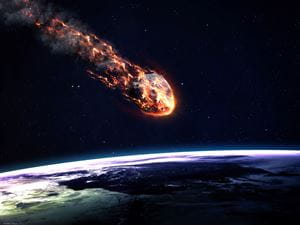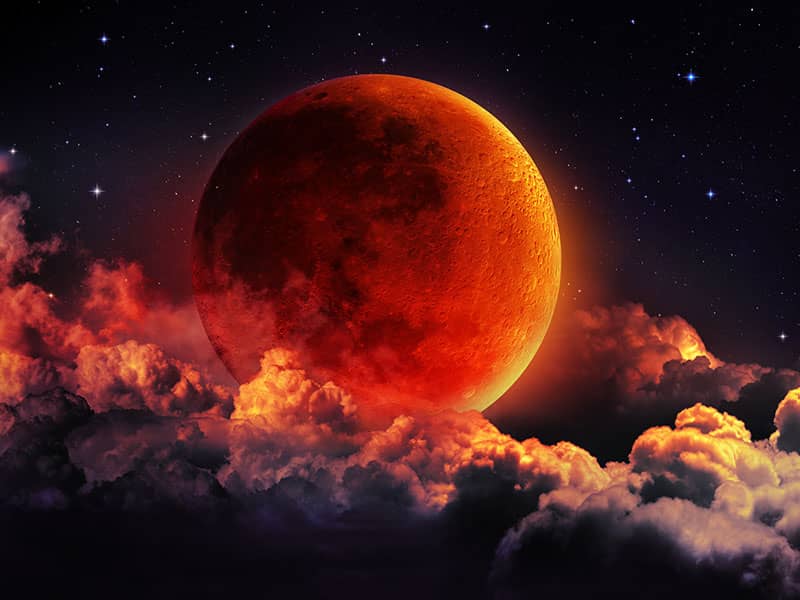
Shutterstock.com
The Book of Revelation is known for its cryptic and dramatic descriptions of the end of the world. Within that lyrical language, however, what is really waiting for those who live to see the end times? What disasters will occur during Revelation when the end of days arrives?
Earthquakes
Earthquakes are mentioned seven times in Revelation. The first is described in Revelation 6:12 and will appear when the sixth seal is opened. At the same time, “the sun [will be] turned black like sackcloth made of goat hair, [and] the whole moon [will be] turned blood red.” A tenth of Jerusalem will collapse in “a severe” earthquake following the death of the final two witnesses, and the earthquake will kill 7,000 people. Several other momentous events, such as the opening of “God’s temple in heaven” are followed or preceded by earthquakes. Perhaps the most concerning earthquake mentioned in Revelation is the one described in Revelation 16:18. “Then there came flashes of lightning, rumblings, peals of thunder and a severe earthquake. No earthquake like it has ever occurred since mankind has been on earth, so tremendous was the quake.” The idea of an earthquake of unheard of magnitude is not good news. Massive earthquakes in the past have done incredible damage. The 2010 earthquake in Haiti is estimated to have killed nearly 320,000 people, and the 1976 Tangshan earthquake killed anywhere from 243,000 people to over 655,000. Both of these, however, pale in comparison to the Shaanxi earthquake of 1556. That quake alone killed almost 1 million people. For a new earthquake to surpass this one is a terrible thought.Meteorite Strikes
The Earth is struck by nearly 500 meteorites every year. Most of these alien visitors, however, weigh little more than a pound. They make for an exciting find for a lucky local or a source of fascination for scientists, but the vast majority of meteorites are harmless to life on Earth. Big meteorites, however, can do untold damage. It is believed to have been a meteorite that was responsible for wiping the dinosaurs off the face of the Earth. As such, Revelation’s warning of “falling stars,” a common name for meteors, is not something to take lightly.Though asteroids and other space objects capture people’s imaginations with their incredible destructive power, Revelation only mentions such things three times. The first is in Revelation 6. Following a solar and lunar eclipse, the “stars in the sky [will fall] to earth.” If this is simply a meteor shower, it will be a spectacular celestial show, but if it is speaking of a sudden onslaught of large meteorites, no wonder “everyone both slave and free [will hide] in caves and among the rocks of the mountains.” There will be nowhere else to go.
The second mention of meteorites describes how “something like a huge mountain, all ablaze” slammed into the ocean. This sounds like the strike of an enormous asteroid. Given that Earth has been hit by space objects the size of mountains in the past, the description of the object looking like a huge mountain may be perfectly literal. Any asteroid that hits Earth is also going to be “all ablaze” after traveling through the atmosphere. That fire will quickly be snuffed out if it hits the water as described, but an oceanic impact brings with it the danger of massive megatsunamis that could devastate global coastlines.
The final time that meteorites are discussed is in reference to the infamous Wormwood. Revelation 8 states that when the third angel sounds their trumpet, “a great star, blazing like a torch, [will fall] from the sky on a third of the rivers and on the springs of water. The name of the star is Wormwood.” Wormwood might well be another massive meteorite as is described previously in Revelation. It might also be something far more destructive, a comet.
Comet impacts with planets are rare simply because comets are so much less likely to enter the Solar System when compared to the millions of asteroids that are constantly floating around the sun. A collision with an icy visitor, after all, is far less likely than slamming into the space rock that lives, in galactic terms, right next door. When comet impacts do occur, however, they are catastrophic. Asteroids tend to land glancing blows on planets, but comets may hit a planet head on. Asteroids also tend to slow down when they hit Earth’s atmosphere as the thick blanket of gases provide resistance. The icy gas that forms a comet’s famous tail, however, would react with the atmosphere to form a natural rocket booster and make the comet, already traveling at least three times faster than any asteroid, pick up even more speed. This would result in a death toll noticeably higher than Revelation’s predicted “many people.” After a direct collision with a comet, it would probably be easier to simply name the lifeforms left alive. The list will be much shorter.
Disease
Pestilence and plague may not be disasters quite as exciting as blazing meteorites or earthquakes that shatter the ground, but disease can be an even larger killer. Revelation surprisingly, however, makes relatively few mentions of disease striking those living during the end times. The most specific is found in Revelation 16 when it is stated that “ugly, festering sores [will break] out on the people who had the mark of the Beast and worshiped its image.” Disease, however, is also described as being an aftereffect of the fall of Wormwood. After Wormwood strikes the Earth, “a third of the waters [will turn] bitter, and many people [will die] from the waters that had become bitter.” To modern ears, this statement suggests that the minerals and gas from Wormwood will poison the waters of Earth. Given that it is implied to be a widespread disaster, this likely indicates that the dust and gases given off by the impact of Wormwood created acid rain which, in turn, poisoned the waters that the rain fell on. Those who drank those waters then fell ill and died.The disasters in Revelation are largely familiar to those who are alive today. That does not, however, make them any less frightening. If anything, it makes the end all the more terrifying. After all, it is one thing to try and conjure up an unfamiliar horror. It is another to know exactly what waits for those who remain on Earth for the end and what they will have to suffer before the final battle draws to a close. The imagination is powerful, but it is reality that paints such a visceral picture of the devastation of the end times and really drives home what it means when Revelation is called the end of the world.

